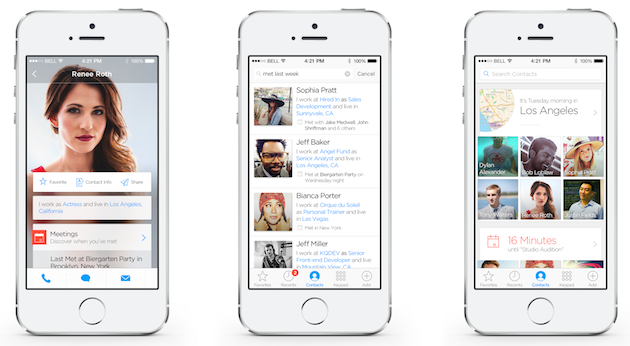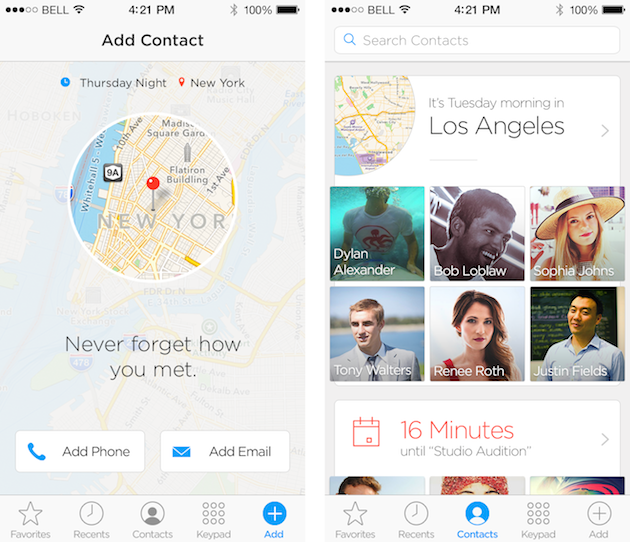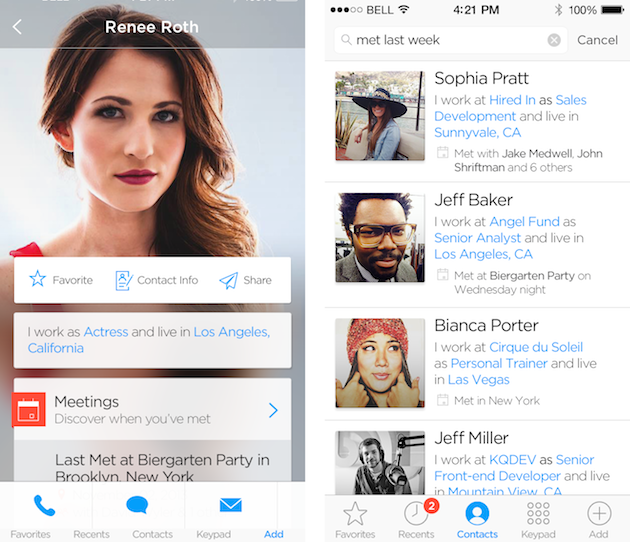
Our phones have changed so much since the early days of the smartphone. We can now use them to take amazing photos, play video games, track our health and fitness and, of course, surf the internet. But the humble contacts app — you know, the thing that stores all those phone numbers — hasn’t changed much, if at all. For one thing, it still lists all those contacts alphabetically. That works if you’ve got a great memory, but what if you want to find that person you met at a party last week and can’t quite recall their name? A normal contacts list would be useless. Launched on the App Store today, Humin plans to change all that, not only by replacing your contacts app, but also by replacing your phone app as well.
Humin aims to do so by adding one key ingredient to contacts: context. Instead of just looking up your contacts by name, for example, Humin lets you look them up by relationship, employer or the time and place you met them. So if I wanted to find that person I met last week, I’d enter in “met last week” in the search field and voila: I’d be able to find him or her much easier. And if that party was on my calendar, I could say something like “met at last week’s party,” and it’d narrow the search down even further.
“The problem we needed to solve wasn’t the contacts problem,” says Ankur Jain, Humin’s co-founder and CEO. “It was the search problem.” He recalled the internet of the late ’90s, where sites like Yahoo and Lycos tried to alphabetize the web in lists and categories. Then search engines like Google came along and you could finally search for things the way our brains actually think. “We’re taking that concept and applying it to people.”

Here’s how it works. When you first launch the app, it’ll ask to hook up to your phone’s contacts and your calendar. You can stop there, but in order for Humin to really flex its contextual muscle, you’re encouraged to connect the app to Facebook and your email account as well (either your Gmail or Exchange accounts will do). It’ll also ask for your LinkedIn info if you have it, which is especially useful if you use your phone for doing business. This is how it gathers data like the people you and your friends know in common, occupations and how frequently people contact you.
And if you really want Humin to replace your phone app entirely, you can. If you go through a few activation steps, you can have it so that all of your missed calls and voicemails will be sent to Humin. Jain tells us the developer actually worked with all the major US carriers to develop this technology. “In order for Humin to really have an impact on your everyday life, it has to be one of the core services that you use on an everyday basis,” says Jain, explaining the reasoning behind the integration.
To be honest, it all feels rather invasive, but Jain assures us that privacy is of the utmost importance. “We keep all of that data on your phone locally … Your email never goes to our servers,” he says. As an experiment, Jain encouraged us to use Humin with Airplane mode on, and indeed, it still managed to do those contextual searches without any connectivity. Of course, this was after we had already fleshed out all our contacts with info gained from Facebook, LinkedIn and the like. Further, the app won’t contact anyone unless you want it to. Which, by the way, you might actually want if you’d like your contacts to have the most updated info. To do so, you can send a verification request to a contact via the app itself.

After you’ve incorporated all that information, Humin really comes into its own. The main Contacts tab, for example, will show all of the contacts who are in the same city as you, as well as the folks who are in upcoming meetings on your calendar. This is potentially useful if you’re traveling — if I fly to New York, it’ll immediately show all the people I know who are in the New York area so that I can instantly send off a quick text to let them know I’m in town. Also, whenever I add a new contact to Humin from now on, it’ll remember when and where I met them, and it’ll automatically add in the person’s name if it’s associated elsewhere. For example, when I entered Jain’s phone number into Humin, it automatically added his name and the 10 people we know in common.
The app also automatically surfaces the people you’re most likely to add to your Favorites list by seeing how frequently you interact and their relationship to you. For me, my co-workers and friends were at the top of the pile, followed closely by family members, which makes sense because most of my communications with family are offline. In order to quickly call or text one of your Favorites, you hold down on their image and either swipe left or right.
I’ve only used Humin for a few days so far, and while I do like it, I’m hesitant to say it’ll truly replace my phone app for everyday use. Dialing a “Favorite” contact is still just a hair faster on the default app (simply tap to call instead of holding and swiping) and the Humin app doesn’t show call duration. The search feature isn’t perfect either. When I wanted to find a list of journalists by looking for “works as journalist,” it wouldn’t include those who described their professions as either “writer” or “editor.” Still, I do think it’s far and away much more useful than the default Contacts app on iOS, which is primitive by comparison. In the end though, I can’t help but wonder if Humin wouldn’t be even more useful if it was integrated right on the OS level so that I wouldn’t have to go through the entire onboarding process in the first place.
If Humin sounds intriguing to you, iPhone users can go ahead and download the app right now. It’s US-only at the moment, but it should arrive in UK stores shortly. Android users will have to wait a few more weeks, and we even hear that Google Glass might get it at some point.
“One of our goals is to put technology into the background of your life,” says Jain. “The phone app is the most background app that you have … We want you to keep that existing user behavior, but bring it to the 21st century.”
Filed under: Software, Apple
Comments
Source: App Store

